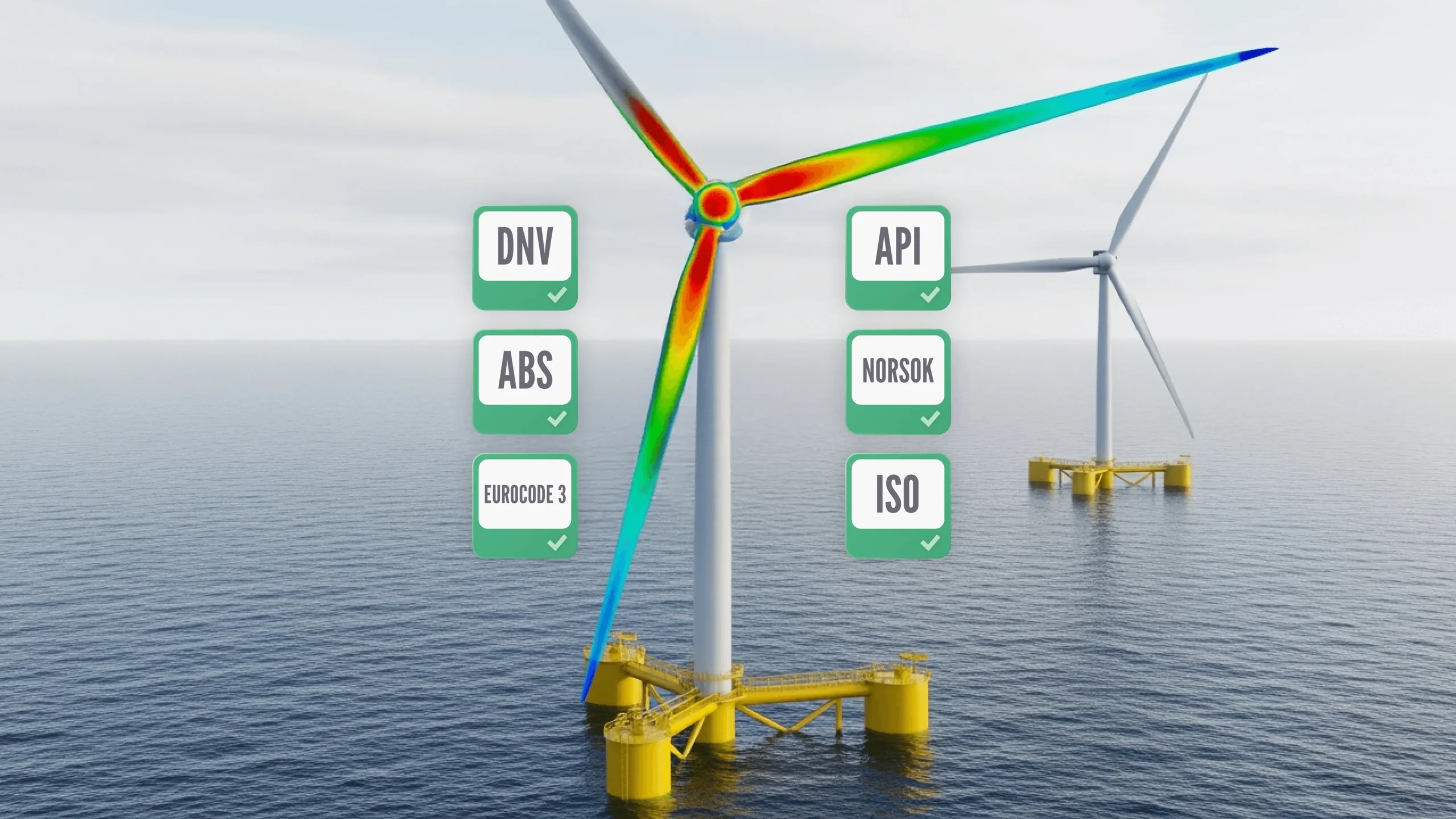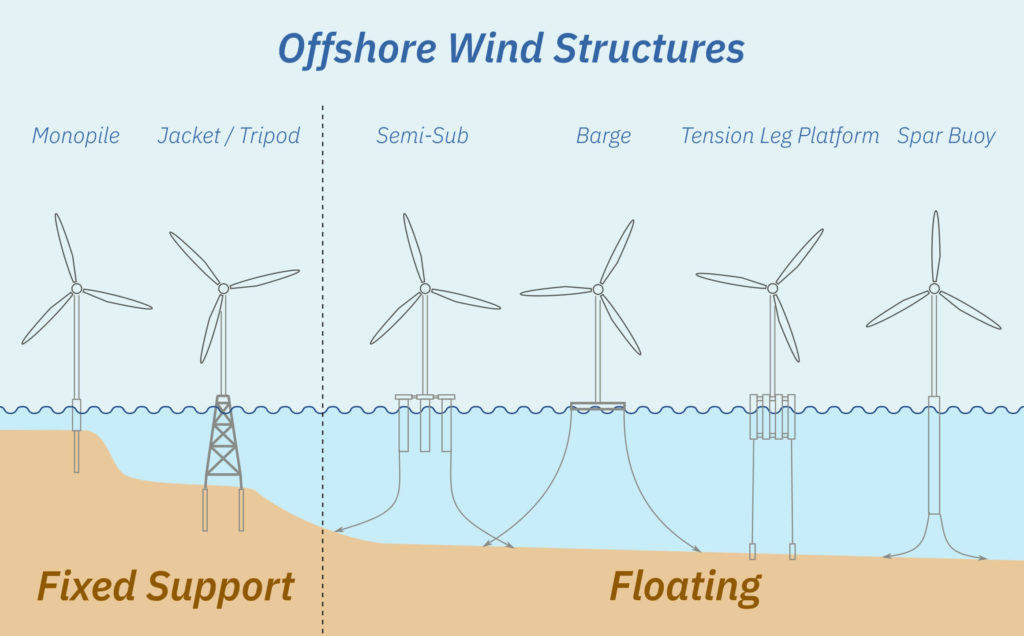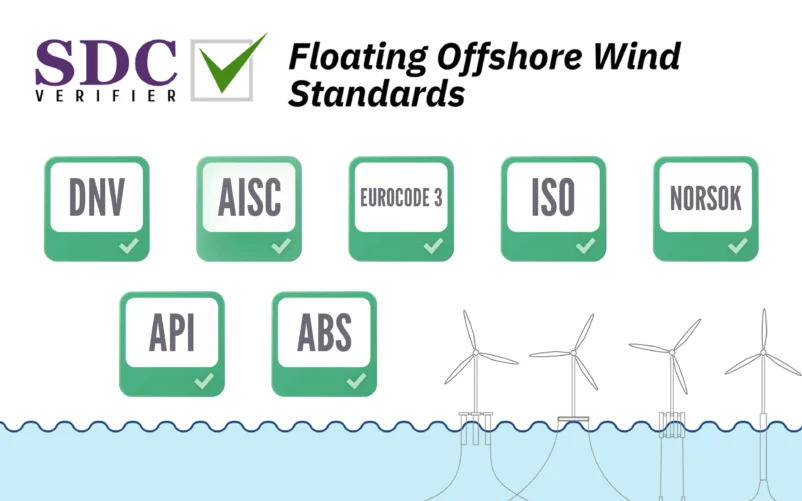Problems of Floating offshore wind plants verification according to industry standards

The demand for renewable energy is growing exponentially, and so is the need for reliably and accurately verified infrastructure involved in the processes.
Offshore wind structures types overview
When it comes to wind energy, there are three main types of plants: onshore, offshore, and floating offshore. Together with the floating offshore wind (FOW) structures, onshore wind, and offshore wind forms the comprehensive wind energy generation system. While onshore wind turbines stay on the ground, offshore ones are anchored to the ocean floor on fixed foundations, and floating turbines are tethered to the seabed by mooring lines and anchors.

Three main FOW designs include a spar-buoy – a long tube extending down from the turbine to balance it below the ocean’s surface; semi-submersible platforms – modular floating cylindrical structures secured by mooring lines; and tension-leg structure with a smaller platform anchored to the seabed with taut mooring lines. Unlike the onshore and nearshore turbines, FOWs eliminate noise and visual pollution, pose less threat to fish and marine mammals, and have less impact on other marine users. Moreover, due to in-port assembling usually don’t need heavy lift vessels for transporting, unlike fixed turbines, and therefore save costs significantly. Also, because of assembling in port, the procedure is less weather dependent compared to offshore structures situated in open waters.
Industry standards, rules, and regulations for FOW
For years, floating offshore wind plants have been a vital part of the energy sector, continuously subject to innovations, and must adhere to a wide range of industry standards, rules, and regulations to operate safely and reliably. Because offshore structures work in extreme-stress environments, it is crucial to predict accurately how they will react to them. The standardization bodies and organizations worldwide have produced codes and standards relevant to the bottom fixed and floating offshore wind industry. In most cases, regulations for bottom-fixed wind structures also apply to floating wind ones.
As DNV and IEC are the leaders in developing codes and standards for bottom fixed offshore wind structures, numerous problems characteristic of floating offshore wind are also covered in their requirements and recommendations. Below are listed the most relevant standards for offshore wind mooring and foundations.
- DNVGL-ST-0054 for Transportation and installation of offshore wind turbines;
- DNVGL-ST-0126 for Support structures for wind turbines;
- DNVGL-ST-0437 for Load and site conditions for wind turbines;
- DNVGL-RP-C203 (Recommended practice for Fatigue Design of offshore steel structures);
- DNVGL-OS-C201 and DNVGL-OS-C101 for weld strength checks;
- DNV-RP-C201 (Buckling Strength of Plated Structures).
While such standards as DNVGL-ST-0119 for Floating wind turbine structures and DNVGL-RU-OU-0512 for Floating offshore wind turbine installations are specific for FOWs, since for floating wind, a more site and floater-specific assessment must be done.
Among the Floating Offshore Wind industry standards, according to Classification and Certification of Floating Offshore Wind Turbines by Bureau Veritas, are:
- AISC’s standards;
- API RP 2A (Recommended Practice for Planning, Designing, and Construction Fixed Offshore Platforms);
- API RP 2T (Recommended Practice for Planning, Designing, and Construction Tension Legs Platform);
- EN 1993-1 (Design of Steel Structures);
- ISO 19902 (Petroleum and natural gas industries – Fixed Steel Offshore Structures).
ABS Guide for Building and Classing of Offshore Wind Turbines also contains detailed information on the rules.

The standards developed cover the requirements for the steel structure in all working conditions and issues that may occur to the offshore structures during the lifetime, including decommissioning stage, where it is crucial to guarantee stability and safe operation. The standards consider wind pressure zones based on average wind speeds and gust factors, providing a framework for assessing wind loads. Because actual wind conditions may vary significantly from the expected ones, the standards guide how to consider the effects of local topography, and shape of the structure, for more accurate calculations. Also, national annexes are often included in global standards to provide specific guidance and information on how the standard should be applied within the specific country based on additional wind zones, specific design wind speeds, and directionality or specific requirements for obtaining building permits, testing, and certification requirements.
Common verification problems of Floating Offshore Wind Plants
Verification of these plants can be complicated and time-consuming, and the potential for costly errors is high. The verification of floating offshore wind plants requires many aspects of their structural integrity to be assessed. What exactly is the load from the waves, wind, and failure risk for the structures? How to check such a complex structure without enormous investments into numerous prototypes? Simulation of the offshore structure model is the proven way to investigate the actual state of the structure analysis. It allows creating and analyzing precise copies of the existing structure or the one which needs to be modified, transported, or decommissioned, understanding the reasons for potential issues and their precise locations, and predicting the structure’s lifetime period.
Typical tasks that stand before structural engineer for floating offshore wind structures are:
- Fatigue assessment – using fatigue standards like DNV-RP-C203 for fatigue analysis;
- Structural stability of all unstiffened and stiffened plates with the stiffeners inside wind tower should be verified, e.g. according to DNV-RP-C20;
- Tubular members, tubular joints and conical transitions shall be designed and checked in accordance to Norsok N004, ISO 19902, API RP 2A-WSD or API RP 2A-LRFD, non-tubular beams, columns and frames must comply with EN 1993-1-1 (Eurocode 3) or AISC standard;
- All bolts and bolted connections which can be designed and checked according to Eurocode 3 (EN 1993-1-8) or AISC standard.
- Wind Turbines’ floating support structures and their station-keeping systems must be designed against Accidental Limit States (ALS).
- Floating concrete support structures for floating wind turbines must be designed in accordance with DNVGL-ST-0126 (Support structures for wind turbines) together with either DNVGL-ST-C502 (Offshore concrete structures) or EN 1992-1-1 (Eurocode 2: Design of concrete structures) as the basic design standard;
- The capacity of all welds must be checked according to DNV OS-C201 or DNV OS-C201.
SDC Verifier proven expertise
SDC Verifier has implemented recommended practices, rules and regulations that can be used for the bottom fixed and floating offshore wind industry structure verification. With SDC Verifier, engineers don’t have to check structures manually one by one element – all the parameters are checked automatically in various combinations of loads and operation modes according to the procedure of the offshore standards. If formulas of the offshore standards need to be adjusted according to company’s requirements or any custom checks are needed, there is an opportunity to write them in the extended formula editor with all FEA data.
If the task is not only to verify Floating Offshore Wind in accordance with the standards, but also come up with a working solution, SDC Verifier has an Optimization module which helps automatically optimize FEA structural elements like beams, plates and weld to pass requirements of the standards.
Report Designer helps to build a calculation report automatically, which is useful for FOW certification or showing the work progress or complete results overview to the client with a short summary at the end.
In the coming years, the use of wind turbines is expected to grow as wind turbines are a useful and emission-free source of electricity. New challenges will undoubtedly arise along with this growth, among them the need to check new and old structures according to industry standards.







